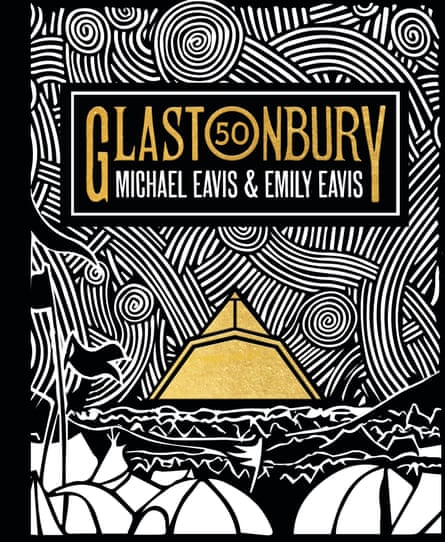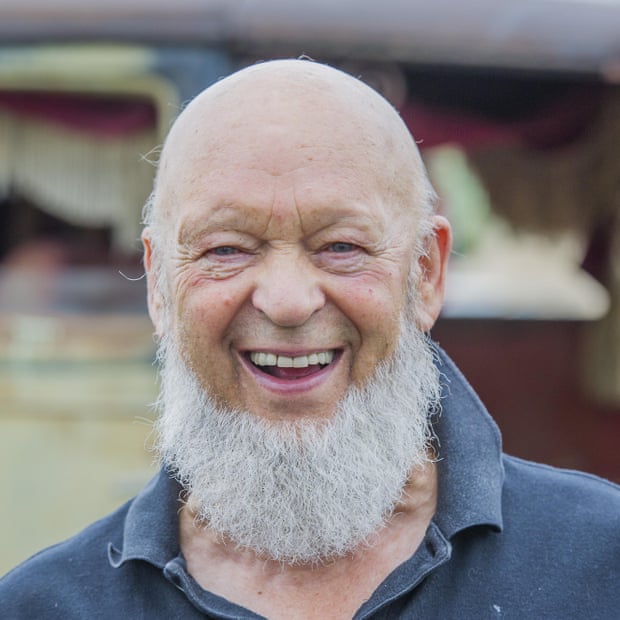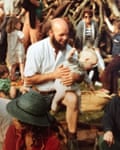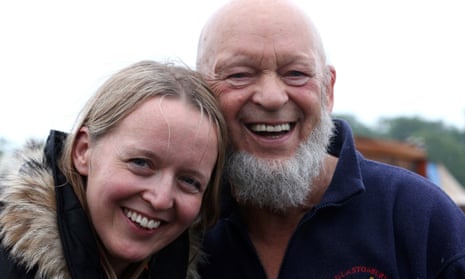Glastonbury founder Michael Eavis and co-organiser Emily Eavis will tell the official story of the world-famous music and arts festival in a new book published to mark next year’s 50th edition.
Emily Eavis told the Guardian: “With our 50th anniversary fast approaching, we felt now was the time to put all of our memories and stories together in one place. It’s been a total joy to look back through piles of old photo albums and scrapbooks and to reflect upon what it meant at the time, and the incredible evolution of the event.”
In the book, Michael Eavis discusses the festival’s precarious existence and the resulting learning curve, including his various run-ins with the council and the police. Emily, who began assisting her father with the running of the festival after the death of her mother Jean in 1999, discusses among other issues the difficulty of the 2008 festival, when Noel Gallagher questioned Jay-Z’s right to headline the festival as a hip-hop performer and tickets didn’t sell out until after the gates had opened.

Glastonbury 50 begins in September 1970, the day after Jimi Hendrix’s death, when Michael Eavis invited 1,000 Somerset revellers to Pilton Pop, Blues & Folk festival on Worthy Farm, charging £1 a ticket for a bill including a headline slot by T Rex, and offering festival-goers free milk from his cows.
Inspired by the Bath festival of blues and progressive music earlier that year, Eavis told his wife Jean he was going to stage a similar event. “If I remember rightly, her reply was, ‘Don’t be silly, you’ve no idea how,’” he recalls in an exclusive extract from the book, available below.
The festival’s identity soon started taking shape: the first year featured the hippy-oriented Green Fields, which remain a key part of modern Glastonbury. In 1971, the main stage was renamed – and rebuilt – as an early incarnation of the Pyramid stage known today. Glastonbury was held sporadically in the 70s before becoming an annual fixture (with occasional fallow years) during the 80s, when its political affiliations with Campaign for Nuclear Disarmament and later Oxfam, Greenpeace and WaterAid began.
The book will feature stories from key figures throughout the festival’s history, including Jay-Z, Adele, Dolly Parton, Lars Ulrich of Metallica, Chris Martin of Coldplay, Noel Gallagher, Pulp’s Jarvis Cocker, Billy Bragg, Peter Hook of New Order, John Cooper Clarke and Suzanne Vega.
The Chemical Brothers – whose 1994 Glastonbury headline set was one of the festival’s first to be televised nationally and was credited with helping bring rave and dance music into the mainstream – will also contribute.

Artists Banksy, Stanley Donwood (who designed the book’s cover art) and Kurt Jackson also appear in Glastonbury 50, alongside writers including Caitlin Moran and Lauren Laverne. The book features photography from the likes of Jill Furmanovsky, Brian Walker and Greg Williams.
Glastonbury 50 is published on 31 October, four months after the 2019 edition of the festival, which will feature headline sets by Stormzy, the Killers and the Cure.
Quick GuideWho runs the Glastonbury festival?
Show

Who runs the Glastonbury festival?
The first "Glastonbury festival" was staged by the then 34-year-old Michael Eavis on the site of his family dairy farm in the village of Pilton in southwest England – about 6 miles from Glastonbury Tor – in 1970. The festival was held intermittently until 1979, when it became a (largely) annual event, and Eavis now organises it with his daughter Emily through the company Glastonbury Festivals Limited. (From 2002 until 2012, promoter Melvin Benn assisted the Eavises with operations and licensing.) Emily and her husband Nick Dewey book the acts for the main stages and oversee the management of the festival's many areas. Each year, the festival donates around £2 million to Oxfam, Greenpeace and WaterAid. The Guardian has been the festival's media partner since 1997.
Ticket prices have increased somewhat since the festival’s first incarnation: tickets for this year cost £248. The festival’s population has also grown, from 1,500 people in 1970 to almost 250,000 – still a slender proportion of the more than 3 million people who register to attend in the annual bunfight for tickets.
This year’s Glastonbury is the first to see organisers ban the sale of single-use plastic water bottles in an attempt to limit the spread of plastics in the oceans and the climate emergency. In 2017, festival-goers got through more than 1.3m plastic bottles. “When you see images of the arena completely covered in old plastic bottles it’s quite haunting,” Emily Eavis told the Guardian in February.

Organisers spent the 2018 fallow year planning the logistics of the ban, which covers suppliers, market managers, area organisers and the backstage area. Water will be available in recyclable cans. Attendees may bring single-use bottles on site, but are encouraged to bring reusable bottles, which will also be on sale at the festival. The move follows bans on plastic cutlery, plates, straws and cups initiated in previous years, along with sauces in single-serving sachets.
Glastonbury caused controversy this week by rescinding an invitation to British punk band Killdren to perform at the festival after the Sunday Times drew attention to their song Kill Tory Scum (Before They Kill You), which includes the lyric: “Tory genocide is the perfect outcome.”
The duo defended the song as a “crude” satire, and said it “would not exist at all if the destructive and violent policies of the Tory party hadn’t taken such a long and devastating toll on the UK. The band does not condone the killing of Tories or children, or anyone for that matter – regardless of political beliefs.”
The organisers of the Shangri-La stage, which was due to host Killdren, said they “in no way condone violence and will not allow this matter to overshadow the incredibly inclusive spirit of Glastonbury”.
Read an exclusive extract from Glastonbury 50, by Michael Eavis
Music had always been a big part of my life. I discovered Radio Luxembourg when I was at boarding school, and I’d listen to it every Sunday night, when Pete Murray and David Jacobs were on. Bill Haley and Bob Dylan captured my imagination, and although I never really went to concerts, I fell in love with pop music.
Before I met Jean, I’d rigged up a very primitive sound system to play music to myself and the cows in the parlour. It was a nine-foot-long pipe connected to a speaker and it made a hell of a sound. I used to play Lola by the Kinks a lot – that was our big milking song. One day in 1970, our baker lady who used to deliver bread to the farm arrived late. She told me it was because she’d been held up in all the traffic going to the Blues festival. I had no idea what she was talking about. She told me it was this big event happening at the Bath & West Showground, a few miles from the farmhouse, and there were millions of people coming for it. “That sounds amazing!” I said, to which she replied, “No, it’s horrible!”
Jean and I agreed that we should go there on the Sunday, after chapel, and it was absolutely incredible. They had Led Zeppelin and Moody Blues and all these west coast American bands. It was the whole flower-power era, and all the girls and blokes looked amazing. It was a very lovey-dovey affair, and emotional, too. I’d never seen anything like it before – it just hit me for six. We were watching Moody Blues, who were playing Question, which is a belter of a song, and I turned to Jean and said, “I’m going to do one of these on the farm!” If I remember rightly, her reply was, “Don’t be silly, you’ve no idea how.”

Comments (…)
Sign in or create your Guardian account to join the discussion